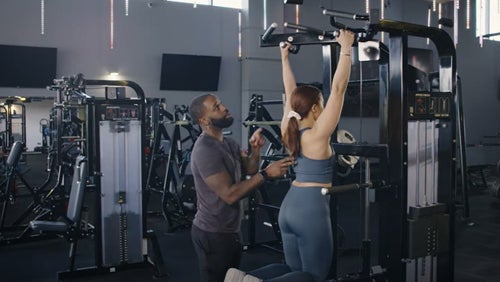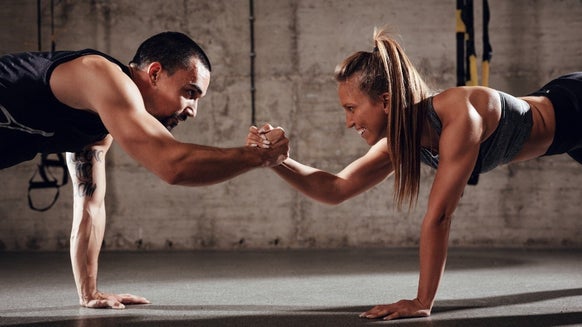 Heading to the gym for a bit of cardio usually means jumping on the treadmill, spending a bit of time on the bike or setting 20 minutes on the Cross-trainer, but the often-overlooked rowing machine should not be underestimated.Other pieces of gym equipment have their benefits and are useful in developing cardiovascular fitness if used appropriately, but why use a treadmill when you can run anywhere? Why not choose a piece of kit that will fulfill all your cardio needs and work your muscles at the same time.Here are some brilliant reasons to choose the rowing machine the next time you visit the gym for some cardio.
Heading to the gym for a bit of cardio usually means jumping on the treadmill, spending a bit of time on the bike or setting 20 minutes on the Cross-trainer, but the often-overlooked rowing machine should not be underestimated.Other pieces of gym equipment have their benefits and are useful in developing cardiovascular fitness if used appropriately, but why use a treadmill when you can run anywhere? Why not choose a piece of kit that will fulfill all your cardio needs and work your muscles at the same time.Here are some brilliant reasons to choose the rowing machine the next time you visit the gym for some cardio.Rowing machine benefits
1. The rowing machine works the whole body
Hallelujah! ONE machine that works the whole body – (great if you’re short for time and you don’t know what to train).When doing cardio in general, using the treadmill for example or the bike, you are not exerting any energy on the upper body therefore, only your legs are getting the work in, as well as your cardiovascular system of course. By pulling out the Rowing Machine, you are introducing a lot of the upper body. This is mainly the muscles used in a pulling motion however, still more than just cycling or running.When you combine the amount of effort required from upper body pulling muscles combined with the initial explosive pushing movement, which involves all the muscles of the lower body, you almost have a cast-iron blueprint to success.
2. Rowing is an effective calorie burner:
Vigorous rowing is one of the highest calorie burners – not to mention the muscles are used to their full range of motion at a joint, vital for keeping the body in balance.Training on a rowing machine can burn up to an incredible 600 calories per hour!The point is that although the rowing-machine may be a slightly more difficult cardiovascular exercise in comparison to the treadmill, cross-trainer or bike – the end results are totally worth it.TIP:More calories burned the better, right? Well then, why not try a little bit of HIIT? I know, I know – you’ve only just come to terms with using the rowing machine more than others… but, actually, HIIT on the rowing machine can give you more of a breather even though it burns MORE calories… Try 30 on 30 off – 30 seconds fast rowing then 30 seconds steady state (secretly classing it as time for a good old breather).Try this for 5 minutes to start with – 10 minutes if you’re feeling good! Your body won’t expect it, therefore forcing it to work harder and get your blood pumping more to catch up after rest!
3. Effective aerobic exercise:
Now you are aware that training on the rowing machine uses a variety of the major muscle groups, it is easier to explain why rowing is such a great form of aerobic exercise.
Using a variety of muscle groups in comparison to cardio workouts that target specific muscles results in an increased heart rate, therefore increasing the amount of oxygen flowing through your body. Don’t worry too much though – see this as a perk as you can control this by choosing a specific resistance on the rowing machine. 4. Prevents upper body imbalances:
In modern day life, we tend to put an over-emphasis on pushing movements, particularly a lot of people who go to the gym to lift weights.Vast amounts of men go to the gym and simply train their upper body muscles which consist of getting big arms and a big chest, with no understanding of the muscular imbalances this can cause.Without a lack of equal training to the antagonist posterior muscles, the humeral head at the shoulder with time is pulled forwards as the chest muscles get stronger, bigger and shorter, making the posture more rounded.Rounded postures place the shoulder joint in an unbalanced position away from the ideal centred position. This unbalanced position leads to increased compression and lack of range of movement at the shoulder likely to cause injury. (Bullock et al, 2005)(Kolber et al, 2010).Thus, by adding rowing with proper form into your workout not only does it allow for a good cardiovascular workout but it helps to pull the shoulder back into its correct position by contracting the muscles of the back. 5. Rowing avoids joint pain
As someone who has had frustrating injuries with both my ankles and knees, I have learnt the hard way not to over-stress the body with activities such as running and playing sports.If you are simply exercising to improve your body composition and cardiovascular endurance, using the rowing machine will be your perfect option.Training on the rowing machine in comparison to other cardiovascular machines relieves a lot of stress on the joints imposed by running as it uses less cyclic movements per minute than effectively any other aerobic exercise.If you suffer from this problem in your current training routine, it would be worth a lot to give rowing a go!I would definitely recommend getting your joints checked by a professional if you are already experiencing joint pain – rowing may reduce the inflammation in comparison to other exercise machines but that’s not to say it will heal issues that are already occurring!
Correct Technique
A rowing machine may look like the easiest piece of equipment to use. – sit down and pull the bar, right?This could not be further from the truth. The Rowing Machine is one of the more challenging pieces of equipment and is guaranteed results if you work hard enough. You can change the difficulty settings to suit your needs as you get used to the move but you’re guaranteed a sweat on. Follow our simple but effective tips to correct your technique:.- Sit down on the seat and find a comfortable position that allows your body to align with the centre of the machine. Keep your bottom securely sat whilst leaning your hamstrings slightly off the edge of the seat.
- Before beginning any movement, adjust the foot straps and foot-holder in front of you until your feet are comfortable and secure (this may seem silly but it makes a huge difference!)
- Use an over-hand grip when grabbing on to the handle with both hands – they should be shoulder width apart. It is important to approach with a loose grip to allow for flexibility and to ‘hang’ off the grip to work the muscles more.
- Perfect your posture:Extremely important to master! A small tip would be to imagine a piece of string going through the centre of your back, from your head to the bottom of your torso – imagine it’s pulled tight. You should be sitting tall with your stomach held in – allow your shoulders to be loose for flexibility.
- When pulling back, make sure you start by leaning forward with legs bent and put arms straight out in front of you.
- Remember to keep your back straight – lean back slightly, straighten your legs and gently pull your elbows close to your body – try not to dig them in – (remember to stay fairly loose for maximum flexibility.)
Common Mistakes and How to Fix Them
Rowing with your arms
Your legs make up the majority of the power output on the movement followed by your core then your arms and back. Don’t rely too much on your arms to complete each rep.Leaning back
You may think leaning back gives you more distance and pull but it doesn’t really. Don’t be tempted into doing this and keep the core engaged and working more efficiently.Rushing
Don’t be tempted into thrashing out as quickly as you can. Be sure to get your rhythm first and once you gauge this, increase the speed of your drive (pull/stroke) when you can.Don’t drive your bum out
Some may try to get extra momentum by driving the legs straight quickly and throwing your bum out quickly. This can place strain on your lower back that is not needed.
Suggested Workouts
For Fat Loss & Anaerobic Improvement
- Warm Up: Steady 500m
- 500m Sprints with 1-minute intervals
- Repeat between 5-10 times depending on fitness
- Record your time and try to improve each workout
For Cardiovascular Endurance
- Longer distance for 20-40 minutes
- Working aerobically just below lactate threshold for best results.
Intervals
- Complete 1x1000m (3 Min Rest)
- Complete 2x500m (2 Min Rest)
- Complete 4x250m (1 Min Rest)
- Finish with 8x125m (Rest 30 Seconds)
As with anything, to achieve results, you need to be willing to work hard! To really push yourself in your workout, try one or all of these methods:- Set a target of what needs to be achieved prior to starting e.g. a time to complete a certain distance
- Find a training partner to compete against.
- Create a good playlist that gets you motivated.
Take home message
Yes, the rowing machine may be a slightly more difficult cardiovascular option, but, remember, if you really want to ramp up your fitness training and add some strength gains in, here you go!
Enjoy this article?READ MORE HERE:















